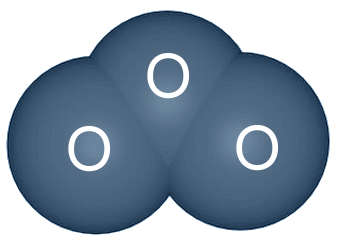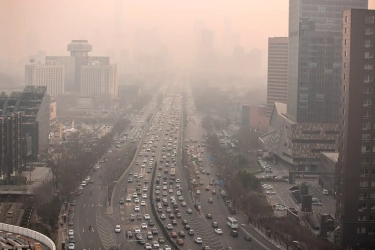  Ozone (O3) is a highly reactive gas composed of three oxygen atoms. It is both natural and man-made, a pale blue gas with a distinctively pungent smell.
Ozone (O3) is a highly reactive gas composed of three oxygen atoms. It is both natural and man-made, a pale blue gas with a distinctively pungent smell. Ozone in the upper atmosphere is formed in trace amounts naturally through the interaction of ultraviolet radiation from the Sun with molecular oxygen (O2). The 'ozone layer', approximately 10 through 50 kilometres high, absorbs UV light and reduces the amount of harmful ultraviolet radiation reaching the Earth's surface. This ozone in the stratosphere absorbs most of the ultraviolet radiation from the Sun. Without ozone, the Sunís intense UV radiation would sterilize the Earthís surface. Ozone screens all of the most energetic UV-C, radiation, and most of the UV-B radiation. Ozone only screens about half of the UV-A radiation; excessive UV-B and UV-A radiation can cause sunburn and can lead to skin cancer and eye damage. Increased levels of human-produced gases such as CFCs (chlorofluorocarbons) used in air conditioning have led to increased rates of ozone destruction, upsetting the natural balance of ozone and leading to reduced atmospheric ozone levels. These reduced ozone levels have increased the amount of harmful ultraviolet radiation reaching the Earthís surface. Fortunately, worldwide bans on the creation and utilization of these chemicals in recent decades have allowed the ozone layer to begin to repair itself.  Ozone is also created at ground level by industrial applications with significant amounts of air pollutants. The majority of ground-level ozone is the result of chemical reactions among these pollutants with energy from sunlight, and occur in the air near chemical plants, gasoline pumps, oil-based paint facilities, industrial furnaces, and motor vehicle exhaust. Where ozone is formed, peak concentrations usually occur during afternoon hours, when sunlight is the most intense. High concentrations of both ozone and the pollutants themselves are toxic to people and plants.
Ozone is also created at ground level by industrial applications with significant amounts of air pollutants. The majority of ground-level ozone is the result of chemical reactions among these pollutants with energy from sunlight, and occur in the air near chemical plants, gasoline pumps, oil-based paint facilities, industrial furnaces, and motor vehicle exhaust. Where ozone is formed, peak concentrations usually occur during afternoon hours, when sunlight is the most intense. High concentrations of both ozone and the pollutants themselves are toxic to people and plants.Ozone in the upper atmosphere absorbs UV light, reducing human exposure to harmful UV radiation that causes skin cancer and cataracts. However, ground level ozone, when inhaled, reacts chemically with many biological molecules in the respiratory tract, leading to a number of adverse health effects. Ozone is also created by electrical discharges. Its unique odour is often evident during thunderstorms when there is intense lightning activity. |